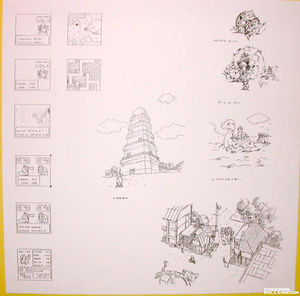Pokémon Red and Green beta: Difference between revisions
m (Protected "Pokémon Red and Green beta" [move=sysop]) |
Aura-Knight (talk | contribs) mNo edit summary |
||
| Line 22: | Line 22: | ||
==Concept art== | ==Concept art== | ||
[[Image:Pokemon conceptart big.jpg|thumb|right]] | [[Image:Pokemon conceptart big.jpg|thumb|right]] | ||
In June 2006, early concept art of Red and Green by [[Ken Sugimori]] was uploaded on Pokémon France's official website. The concept art depicts rough versions of various concepts that made it into the final game. They seems to include various {{pkmn|battle}}s, the [[Kanto Safari Zone|Safari Zone]], {{ga|Red}} riding on a {{p|Lapras}}, a {{p|Blastoise}}, [[Celadon City]], [[Silph Co.]] and a town with a fountain with could have been reworked into [[Celadon City]]. | In June 2006, early concept art of Red and Green by [[Ken Sugimori]] was uploaded on Pokémon France's official website. The concept art depicts rough versions of various concepts that made it into the final game. They seems to include various {{pkmn|battle}}s, the [[Kanto Safari Zone|Safari Zone]], {{ga|Red}} riding on a {{p|Lapras}}, a {{p|Blastoise}}, [[Celadon City]], [[Silph Co.]] and a town with a fountain with could have been reworked into [[Celadon City]]. Some other Pokémon are identifiable in a raw or semi-normal form, such as {{p|Gastly}} and others are proto-typical of an entire class of Pokémon, such as a basic {{type2|Dragon}}. | ||
==References== | ==References== | ||
Revision as of 03:00, 31 January 2009

|
This article does not yet meet the quality standards of Bulbapedia. Please feel free to edit this article to make it conform to Bulbapedia norms and conventions. |
Pokémon Red and Blue Versions were the first Pokémon games to be released in the US, on September 30, 1998. Several prototype elements of the game have been discovered by ROM hackers who have examined the game's code.
Professor Oak wants to fight
Professor Oak has a full team of Pokémon programmed into the game, although the battle cannot occur during a normal game. The player must use a GameShark code to start the battle. Professor Oak has a level 66 Tauros, a level 67 Exeggutor, a level 68 Arcanine, a level 69 starter evolution, and a level 70 Gyarados. He has the same team in Pokémon Yellow Version. When he is defeated, he says: "That can't be!". This implies that the player may have been able to face him at some point, presumably after the Elite Four, seeing as how his Pokémon are high-leveled.
The Bug Catcher wants to fight
Before Red and Blue's U.S. release, screenshots were released of a rival battle with the text "The Blue wants to fight." While this text would work with a typical trainer such as "The Lass" and "The Hiker", it would cause problems with Gym leader battles: the names would end up as "The Brock" or "The Misty". In the final version, the word "the" is dropped.
Chief
There is a prototype Trainer class omitted from the final version of the Generation I games. It is, however, in the game's code. A Chief is mentioned by a Team Rocket Grunt in Celadon City and can be battled through the Old Man glitch. He can be also battled by cheating with a GameShark or similar device. Chief's sprite is identical to that of a Scientist.
Female character
There were originally plans for a female character to be playable in Red and Green, as older sketches suggest.[citation needed] Blue from Pokémon Special seems to be based on her. The character was redesigned and included in the remakes of the game, to continue the standard of including a female protagonist option.
Template:Type2
The Bird-type may have been a prototype version of Template:Type2. This can be seen in the final version of the game: Missingno, the infamous glitch, is part Bird-type. The Bird type is present in the Generation II games' programming; this is unsurprising, since the game engine for Gold and Silver is based on that of the Generation I games.
Surfboard
There is an item in the game that enables the user to Surf without using a Pokémon.[1] This may mean that the move Surf was not implemented as an attack originally, or that the HMs did not initially exist. However, the Surfboard may instead have been a prototype object for testers to advance quickly through the game.
Concept art
In June 2006, early concept art of Red and Green by Ken Sugimori was uploaded on Pokémon France's official website. The concept art depicts rough versions of various concepts that made it into the final game. They seems to include various battles, the Safari Zone, Red riding on a Lapras, a Blastoise, Celadon City, Silph Co. and a town with a fountain with could have been reworked into Celadon City. Some other Pokémon are identifiable in a raw or semi-normal form, such as Gastly and others are proto-typical of an entire class of Pokémon, such as a basic Template:Type2.
